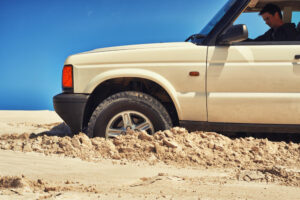There’s nothing quite like the freedom of driving across the sandy shores of Virginia Beach with the windows down and the ocean breeze in your hair. Beach driving offers a unique way to explore coastal areas that are otherwise difficult to access, but it also presents challenges that regular road driving doesn’t. The soft, shifting sand beneath your tires requires specific preparation, techniques, and vehicle modifications to ensure a fun, safe experience.
At Green Light Towing Service, we’ve rescued countless vehicles with our beach towing services when they’ve become bogged down in Virginia Beach sand. Through our experience providing off-road recovery services, we’ve gained valuable insights into what makes for successful beach driving adventures. Give us a call at 757-938-3378 if you find yourself stuck, but our goal is to help you avoid that situation entirely!
In this guide, you’ll learn about Virginia Beach’s unique driving conditions, essential vehicle modifications, pre-trip preparation steps, proper driving techniques, and what to do if you get stuck. With the right knowledge and equipment, you’ll be well-prepared to enjoy all that beach driving in Virginia Beach has to offer.
Understanding Virginia Beach Driving Conditions
Virginia Beach offers several areas where beach driving is permitted, each with its own unique characteristics. Before hitting the sand, it’s crucial to understand what makes beach driving here different from regular off-roading.
The sand consistency at Virginia Beach varies significantly depending on location, recent weather, and tidal patterns. Areas near the water’s edge typically provide firmer sand that’s easier to drive on, while dry, deep sand further from the shoreline can quickly trap unprepared vehicles. Seasonal changes also affect driving conditions—summer heat dries out sand, making it looser and more challenging to navigate.
What about tides? They play a critical role in beach driving safety. High tides can reduce the available driving area and create soft, wet sand that’s deceptively difficult to drive through. Always check tide schedules before your trip and plan to drive during low tide when possible.
The weather in Virginia Beach can change rapidly, especially during spring and fall. A sunny morning can turn into an afternoon thunderstorm, transforming passable sand into a vehicle-swallowing trap. Monitor weather forecasts closely and be prepared to adjust your plans accordingly.
Legal beach driving in Virginia Beach is limited to specific areas and often requires permits. These areas include:
- Sandbridge (4×4 access only, permit required)
- False Cape State Park (with restrictions)
- Certain portions of the Outer Banks just south of Virginia Beach
Always verify current regulations before your trip, as access rules can change seasonally or based on environmental conditions.
Essential Vehicle Modifications for Beach Driving
Your vehicle’s setup makes all the difference between an enjoyable beach adventure and an expensive recovery operation. Let’s look at the most important modifications for successful beach driving.
Tire Selection and Pressure Management
Tires are your most critical connection to the sand. All-terrain tires with aggressive tread patterns provide better traction than standard highway tires. However, tire pressure management is even more important than tire type.
Airing down your tires is essential for beach driving success. Reduced pressure increases your tire’s footprint on the sand, distributing your vehicle’s weight over a larger area and reducing the likelihood of sinking. For most vehicles, dropping to 15-20 PSI works well on beach sand. However, never go below the minimum pressure recommended for your tire size and vehicle weight.
Don’t forget that you’ll need to reinflate your tires before returning to paved roads. A good portable air compressor is a must-have item for any beach driving kit. Look for models that connect to your vehicle’s battery and can reinflate your tires within 10-15 minutes per tire.
Recovery Equipment Every Beach Driver Should Carry
Even the most experienced beach drivers occasionally get stuck. Having the right recovery gear can mean the difference between a minor delay and calling for professional help.
Essential recovery items include:
- Recovery boards (such as MAXTRAX or similar): These provide instant traction when placed under spinning tires. They’re lightweight, durable, and incredibly effective.
- A good shovel: Sometimes you need to dig yourself out before using other recovery methods. A collapsible shovel saves space but still gets the job done.
- Tow straps and shackles: If another vehicle is available to help, proper tow straps (rated for your vehicle’s weight) and shackles allow for safe recovery attempts.
Helpful Vehicle Modifications
While not absolutely necessary, these modifications can significantly improve your beach driving experience:
- Increased ground clearance: Factory SUVs and trucks usually have adequate clearance, but aftermarket lift kits can provide extra space between your undercarriage and the sand.
- Skid plates: These protect vital components like your oil pan and transmission from damage if you do bottom out.
- Enhanced bumpers with recovery points: Factory tow points aren’t always ideally positioned for sand recovery. Aftermarket bumpers often include multiple strong recovery points specifically designed for extraction.
Pre-Trip Preparation for Safe Beach Driving
Successful beach driving starts before you leave home. Proper preparation prevents most common problems and ensures you’re ready for unexpected challenges.
Start with a thorough vehicle inspection. Check all fluids, tire condition, brakes, and ensure your four-wheel drive system is functioning properly. Beach driving puts additional stress on your vehicle, so addressing small issues beforehand prevents bigger problems on the sand.
Check tide tables for your planned driving area. The ideal time for beach driving is typically within two hours on either side of low tide when the sand is at its firmest. Many smartphone apps provide accurate tide information for Virginia Beach.
Research permit requirements and regulations for your chosen beach driving area. Some sections require advance permits, have seasonal restrictions, or limit the types of vehicles allowed. Breaking these rules can result in significant fines.
Pack essential supplies including:
- Extra water and non-perishable food
- Sunscreen and sun protection (beach driving exposes you to intense sun)
- Basic tools and spare parts
- First aid kit
- Communication devices (cell phone coverage can be spotty in some areas)
Beach Driving Techniques and Best Practices
How you drive on sand makes all the difference. The techniques that work on pavement can get you stuck in seconds on the beach.
Maintain steady momentum without excessive speed. The ideal pace for beach driving is typically 15-25 mph—fast enough to maintain forward motion but slow enough to react to obstacles or changes in sand consistency. Sudden acceleration causes tires to dig in rather than ride on top of the sand.
When encountering soft sand sections, resist the urge to power through them. Instead, maintain a constant throttle position and steer with minimal input. Aggressive turning cuts into the sand and can quickly bog down even capable vehicles.
Following existing vehicle tracks isn’t always the best strategy. While they might indicate a successful path, they can also create deep ruts that may bottom out your vehicle. Choose the path that best suits your vehicle’s capabilities.
If you feel your vehicle beginning to bog down, don’t panic and floor the accelerator. Instead, back off slightly and try to maintain momentum while steering toward firmer sand if possible. Gentle back-and-forth movements can sometimes work you free before you’re fully stuck.
Remember that you’re sharing the beach with pedestrians, wildlife, and other drivers. Drive respectfully, yield the right of way when appropriate, and never drive in protected or restricted areas.
What To Do If You Get Stuck
Despite best efforts, getting stuck happens to even experienced beach drivers. Your first response is crucial in determining whether you’ll need professional help.
Stop spinning your tires immediately. Continued spinning only digs you deeper and makes recovery more difficult. Turn off your vehicle and assess the situation carefully.
Start by clearing sand away from your tires and vehicle undercarriage. Sometimes removing the built-up sand is enough to get moving again. Place recovery boards directly in front of (or behind) your tires, depending on which direction offers the easiest exit.
If self-recovery attempts aren’t working or you’re in a dangerous situation (rising tide, extreme weather), it’s time to call for professional help. At Green Light Towing Service, our specialized off-road recovery equipment can safely extract your vehicle with minimal additional damage.
While waiting for assistance, ensure all occupants are safe, hydrated, and protected from the elements. Stay with your vehicle unless it’s being threatened by rising water.
Conclusion
Beach driving in Virginia Beach offers unforgettable experiences and access to some of the most beautiful coastal areas in Virginia. With proper preparation, equipment, and techniques, you can minimize risks and maximize enjoyment of this unique activity.
Remember that successful beach driving comes down to preparation and respect—for your vehicle’s limitations, for the environment, and for other beach users. The right tires, proper pressure, essential recovery gear, and knowledge of driving techniques will serve you well on the sand.
At Green Light Towing Service, we’re committed to helping Virginia Beach off-roaders enjoy safe adventures. While we’re always ready to help with professional off-road recovery services at 757-938-3378, we’d rather see you driving confidently on the beach than needing our assistance. Plan carefully, drive smart, and enjoy all that Virginia Beach’s beautiful shoreline has to offer!




